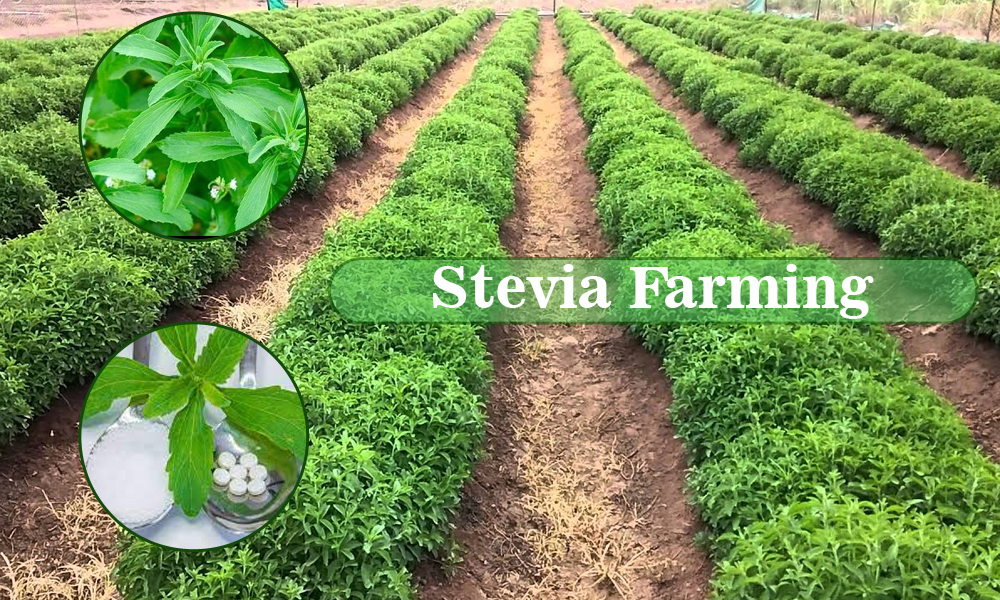
Stevia Plant Farming Introduction
Stevia Plant Farming Introduction of Stevia Plant:
Stevia is a shrub-like perennial plant that is used as a sugar substitute and in the treatment of some health conditions for years. This is also called “sweet leaf, sugar leaf and honey leaf “. The leaves of the Stevia plant is the source of zero-calorie sweetener and the sweetness of this plant more than sugar. The cultivation of the Stevia plant is also introduced in India and this is picking up in a great way. This plant has the property of lowering blood sugar levels, hence this is considered to be a great plant for diabetic patients.
Health Benefits of Stevia Plant:-
Some of the health benefits of Stevia are as follows.
- Stevia may lower blood sugar levels.
- Stevia may control high blood pressure.
- Stevia may beat acne & dandruff.
- Stevia may help in protecting teeth & gums.
- Stevia may help in reducing indigestion & heartburn
- Stevia may help in reducing wrinkles & fine lines.
- Stevia may help in weight loss.
- Stevia may help in healing wounds faster.
High Yielding Improved Varieties of Stevia Plant in India:
In India, there are 2 most popular verities of Stevia plant developed for low care and high yielding. These varieties are best suitable for Indian climatic conditions and soils. MDS -14 and MDS-13 are the improved cultivars of the Stevia plant developed for high temperature and drought/low rainy regions.
Climate Required for Stevia Plant Farming:
Stevia plant crop requires about 150 cm rainfall annually and prefers an average temperature of 30°C to 32 °C for its best growth. High temperatures above 45°C and nightly temperatures below 5°C will damage the crop.
Soil Requirement for Stevia Plant Farming:- Stevia plant grows best in well-drained, rich, red and sandy loam soils. This plant prefers acidic to neutral soils with a fine tilth. Soil pH range should be about 6.0 to 7.5 for its best growth and yield. In the case of poor soils, applying good organic matter and micronutrients would fetch a good yield of Stevia.
Land Preparation, Spacing in Stevia Plant Farming:- To break down the clods and make weed-free soil, the land should be harrowed and then plowed. 2 to 3 ploughings with a tractor or local/country plow would make the soil fine tilth. Make sure the land is not susceptible to flooding and pudding. The raised beds should have 12 to 15 cm in height & 50 to 60 cm in width. Row-to-Row distance should be 40 to 45 cm and Plant-to-Plant distance should be about 30 cm. This calculation gives Stevia plant density as 20,000 to 25,000 plants per 1 acre.
Propagation in Stevia Plant Farming:- In Stevia plant farming, propagation is done by stem cuttings. The length of the stem cutting should be about 15 cm and should get it from leaf axils of the current year’s growth to have better yielding results. The best season for Stevia propagation is from Feb to Mar. The cuttings will be ready for transplanting after 4 weeks of rooting.
Planting Season in Stevia Plant Farming:- Feb-to- March of the year.
Plant Population in Stevia Plant Farming:- Plant density in Stevia cultivation is about 20,000 – 25,000 plants per acre.
Manures and Fertilizers in Stevia Plant Farming:- Stevia crop responds well to fertilizers and manures with lower nitrogen content. It is a good idea to have organic manures due to the slow release of nitrogen. Adding Farm Yard Manure (FMY), Vermicompost, cow dung/urine will be beneficial for better crop yield. The fertilizer dose of NPK of 28:113:113 kg/hectare is recommended for high yield of Stevia crop.
Irrigation in Stevia Plant Farming:- Irrigation can be carried out by traditional methods or drip/micro-sprinklers. However, using drip irrigation system or micro-sprinkler system is best for irrigating Stevia crop. Frequent light irrigation should be carried out in hot summer months. In winter or rainy season, this crop may not need frequent watering. Avoiding excessive moisture levels in the soil is not favorable for its growth.
Weed Control/Intercultural Operations in Stevia Plant Farming:- Usually, there are hardly or no pests and diseases found in the Stevia crop. If any pest or disease is noticed, spraying neem oil by diluting water is the best organic method. Removal of weeds should be done manually. Intercultural operations in the Stevia crop are easy for labour, since the crop is grown on raised beds. Avoid the flowering of the plant. However, regular weeding @ 8 weeks interval should be carried out.
Pests and Diseases in Stevia Plant Farming:- There are no pests and diseases found in Stevia crop, If anything is noticed, spraying neem oil with diluted water would work just fine.
Harvesting of Stevia Plant:- Usually, Stevia plants become ready for first harvesting when they attain 40 to 60 cm in height (or) 4 to 5 months after planting. Thereafter, harvesting can be carried out every 3 months for 3 years. The Stevia plants should be cut just before flowering starts as the sweetener in its leaf would be maximum at this time and also can get good quantity at this point in time. Harvesting can be done by plucking in a small quantities or the whole plant leaving 15 cm from the base.
The yield of Stevia Plant Leaves:- An average yield of 2500 to 2700 kg’s of dried Stevia leaves per acre can be obtained with crop management practices and good variety.
Post Harvesting in Stevia Plant Farming:– As part of post-harvesting, Stevia plant branches should be dried in shade for 2 days. Dried Stevia leaves should be separated, threshing into powder and stored in containers.
Bottom Line of Stevia Plant Farming:- As long as diabetic patients exist in this world, this plant crop never go down. Excellent returns can be expected out of Stevia cultivation.